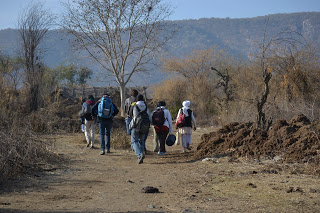The team from the Law, Environment and Design (LED) Lab, a new partnership between Natural Justice and the Srishti School of Art, Design and Technology, visited three villages in the core area of the Sariska Tiger Reserve to begin a resource mapping process with the Gujjar community. The team was accompanied by KRAPAVIS, a local NGO. The team worked with the community on a cognitive mapping exercise where different groups gathered to fill the chart paper with their understanding of the space they lived in. These cognitive maps became an effective tool to document the injustices caused by the denial of their rights to access the forest after its declaration as a tiger reserve. The LED Lab team conducted meetings with the Gram Sabha in each village to understand the status of implementation of the Forest Rights Act, 2006 and through this determined that knowledge of the Act was limited. The design students accordingly decided to develop a graphic novel that chronicles the different provisions of the Act and describes its interaction with potentially conflicting laws like the Wildlife Protection Act, 1972. The team also visited relocated villages where communities are still struggling with the dramatic transition and heard of the lack of community consultation through the relocation process. The LED team will now work towards creating a simple relocation chart that will detail options available along with experiences and challenges faced by other villages.

